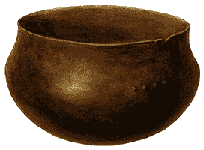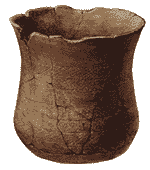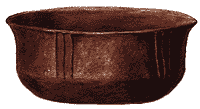- Home
- Discover the megaliths of Morbihan
- Art reflects the sacred
- Everyday objects
Everyday objects had to stand harsh conditions of manufacture (the stone had to be resilient enough; clay would shrink when drying out or firing) and use (potteries had to be watertight, steady and even fire resistant, axes had to be balanced, etc.)
Everyday objects may be considered works of art either because of their decoration or their general aesthetics (often related to ergonomics).
Ceramics are used as 'cultural landmarks' because:
- they are easy to make : from the Neolithic onwards, men have used them for many different purposes ;
- their plasticity means they can be moulded into many different shapes ;
- being fragile and in need of frequent replacement, they follow changes in fashion and customs ;
- broken fragments are both unusable and virtually indestructible, so they are easy to find.
In western France, during the Neolithic, several processes were used to ornament ceramics:
- small incisions made before or after firing,
- wide but shallow channels, made by burnishing the paste with a blunt arrowhead,
- hand-made punches, combs or cords or natural die-stamps (shell edges or 'apexes') ,
- paste cords or dots pressed against the pottery sides to create a 'plastic' decoration in relief.
Although there is sometimes white paste inlayed in incised or stamped patterns, no painted decorations can be found in our area.
In the early Neolithic, potteries were simply shaped : they were designed as more or less open, round-bottomed bowls.
But soon their shape and their use became more diversified. Some potteries were used not only for domestic purposes but also for worship:
- footed cups (also called 'vase supports' owing to their use as pedestals for round-bottomed bowls) apparently used as incense-burners,
- hollow stemmed pots used for libations,
- bowls with an internal cup depression possibly used in the preparation of various potions,
- 'micro-pots' (some holding no more than a few cubic centimeters) for ointments.
The Late Neolithic 'collared flasks' were likely to belong to this family.
Some terra cotta statuettes were excavated on some Middle Neolithic sites in the Paris basin but none were found in the West of France
Next slide
Previous slide
Large round-based pottery from the Moustoir tumulus, ornamented with raised buttons.
A typical bell beaker with comb decorations.
Bowl from the " Kerugou group" ornamented with clay beadings applied on the outside.
The footed cup from the Moustoir dolmen, with both moulded and incised decorative motifs (the cross section shows the cup structure).
Two "micro-pots" from the Armorican Middle Neolithic.




